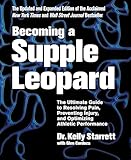Physical pain has been a recurring teacher in my life. Each injury forced me to learn something about how my body works (and doesn’t). This page is the hub for my pain-related learnings, with dedicated pages for each area where I’ve had issues.
- Places I’ve Had Pain
- Key Concepts for Pain Management
- Approaches to Managing Pain
- Great Books For Across the Board Improvements
- Other Ideas to Classify
Places I’ve Had Pain
Shoulder Pain
Back Pain
Knee Pain
Key Concepts for Pain Management
Tightness is the signal/symptom it is not the problem.
Physical pain has a direct analog to mental pain — both use discomfort as a signal, not the root cause:
Mental Pain => Anxiety => Signal to Focus => Instead of asking why am I anxious, and what am I trying to control, how do I maximize my influence
Physical Pain => Tightness => Signal to Focus => Instead of asking how do I loosen, ask what is weak? how do I strengthen.
Negative Feedback loop - When you are tight.
Your body is designed to operate smoothly and symmetrically. However, we can also operate with mitigations, but those are of course increasing our injury risk. So if we’re tight on one side we compensate, and that puts us at higher risk of future injury.
Flexibility vs Mobility
These aren’t synonyms — they’re two different but related concepts. The distinction matters because it tells you what to train:
| Flexibility | Mobility | |
|---|---|---|
| Definition | Passive ROM — how far you can be moved (by gravity, a partner, or strap) | Active ROM — how far you can move yourself under own control |
| Limited by | Tissue stiffness, ligaments, joint structure | Strength and motor control |
| Test | Can a physio push you into the position? | Can you get there yourself and hold it? |
The key insight: The gap between your flexibility and mobility is a strength/control deficit, not a stretching problem.
Example: You might be able to touch your toes when you relax and hang (flexibility), but struggle to actively lift your leg to 90° while standing (mobility). More stretching won’t help — you need strength work in that range.
Practical implications:
- If you’re flexible but not mobile → train strength at end-range (e.g., loaded stretches, isometrics)
- If you’re not even flexible → address tissue restrictions first, then build strength
- Chasing flexibility without mobility creates “loose but weak” joints — injury waiting to happen
So why do we do massage, and stretch
Because while that tightness is a symptom, it’s also limiting range of motion, and by loosening (even temporarily), we can be more effective at strengthening (again exactly the same as anxiety in mental pain).
Approaches to Managing Pain
Physio Therapy
Physio therapy is a great model for improvement. You go, they coach you, and then you have to do the work.
Critical because Practice makes permanent. See
Massage, Stretch, Strengthen
Massage (aka Release) feels amazing, stretching good, and Strengthening Does Nothing. Inconveniently, massage only lasts 20 minutes, stretching a day or 2, but strengthening lasts forever.
Self Release: Massage and Foam Roller, Tennis Ball
- Foam roller and Tennis ball are mostly self massage, which is mostly less effective than an expert nailing it.
- Remember this is not fixing the problem, it’s giving you a window to maximize your efficiency in fixing the problem.
Great Books For Across the Board Improvements
- Rebuilding Milo - From the Squat University guy (Aaron Horschig). Focuses on diagnosing and fixing common lifting injuries (hip, knee, shoulder, back). Very practical with specific rehab protocols and movement assessments.
- Built from Broken - Scott Hogan’s science-based approach to joint health and injury recovery. Covers the “why” behind pain and provides structured programs for rebuilding strength after injury. Good on nutrition’s role in tissue healing.
Other Ideas to Classify
Using the 5 whys to understand pain
From our favorite COE process - the 5 whys:
- Why Pain?
- Tightness
- Why Tightness?
- Body Protecting From Injury
- Why Protecting From Injury
- Body feels instability in joints
- Why unstable?
- Lack of muscular Endurance
This is what’s great about the mcgill big 3, it’s isometrics to build endurance, as opposed to strength. And it does so with the minimal amount of back load (which would worsen the injury)
Rotation for stiffness
OK, a very hard to read book “Becoming a Supple Leopard”, but a point which he hammers in that no one else does is the importance of external rotation, both in the hips and in the shoulders:
Coaches talk about “bending the barbell”, or rotating your pits forward or screwing your feet into the ground. What they are “cueing” you for is to externally rotate your humerus or femur into the socket, this pulls the slack out of the joint making it stiff.
Note in the hips, when you point your feet out you have more ROM, but you lose tension, and that tension has downsides — being stiff gives you strength.
Shoulder external rotation was really hard for me, and also interesting since the way I do pushups is I let my elbows go perpendicular to my core (which is apparently not what you want).
Lack of shoulder external rotation meant I had really weak wrists and put extra strain on my wrists.
To have strength, you need stability or your body shuts off strength to avoid injury (hopefully). You have a few ways to get stiffness: one is stiffening random muscles, the other is external rotation.


